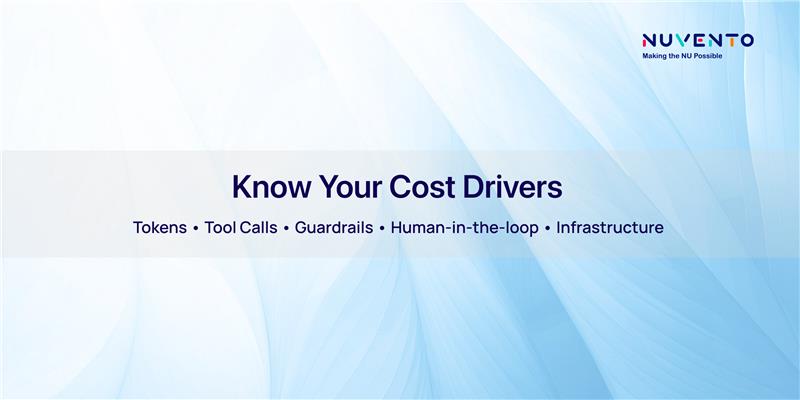
28 Aug Choosing the Right AI Agent Pricing Model: A Guide for Businesses
As agentic AI moves from pilots to production, the biggest question isn’t “Can it work?”, it’s “What will it cost, and is that cost tied to real business value?”
Pricing models for AI agents can feel opaque: tokens, context windows, tool calls, guardrails, human-in-the-loop, and more. Choose well and you’ll get predictable budgets, aligned incentives, and clear ROI. Choose poorly and you’ll face surprise bills, stalled adoption, and hard-to-defend outcomes.
This guide breaks down how AI agents incur costs, the pricing models you’ll see in the market, how to match them to your use cases, and practical steps to forecast and negotiate. It’s written for business and technical leaders evaluating agentic AI, especially those partnering with Nuvento on strategy, build-out, and optimization.
What actually drives AI agent costs
Before picking a pricing model, know the cost drivers under the hood:
- Language model usage: Prompt and response tokens, model family (e.g., lightweight vs. reasoning models), context window size, and function/tool calls all impact price.
- Tool and API calls: Search, databases, CRM/ERP, payment gateways, each call may have its own fee.
- Orchestration and memory: Multi-step reasoning, planning, multi-agent handoffs, and long-term memory increase token use and compute.
- Retrieval and vector storage: Embedding creation, vector DB queries, and storage fees.
- Guardrails and safety: Content filtering, red teaming, and policy checks add compute.
- Observability: Traces, logs, evals, and monitoring pipelines can be significant at scale.
- Human-in-the-loop: Reviews and escalations add operational cost but reduce risk.
- Hosting and infrastructure: Serverless invokes, GPUs for self-hosted models, data egress, and regional compliance.
Understanding these helps you forecast total cost of ownership (TCO), not just the “headline” token price.

Common AI agent pricing models (and when to use them)
Usage-based (pay-as-you-go)
- How it works: Pay per token, API call, minute, or compute unit.
- Best for: Variable workloads, early pilots, seasonal use.
- Watch outs: Volatility; set budgets, rate limits, and alerts.
Per-seat or per-agent license
- How it works: Fixed price per user or per named agent instance.
- Best for: Internal assistants with a predictable user base.
- Watch outs: Misaligned incentives if heavy users trigger hidden overages elsewhere.
Tiered subscription (with quotas)
- How it works: Flat monthly fee for a bundled allowance; overage if exceeded.
- Best for: Mid-sized teams seeking predictability.
- Watch outs: Overage rates can be steep; define throttling or graceful degradation.
Outcome-/transaction-based
- How it works: Pay per resolved ticket, order processed, qualified lead, etc.
- Best for: High-volume use cases with measurable outcomes.
- Watch outs: Requires precise attribution and quality thresholds to prevent gaming.
Hybrid (platform fee + metered usage)
- How it works: Base platform/license plus pay for tokens and tool calls.
- Best for: Most enterprise deployments.
- Watch outs: Demand transparency on both components; track pass-through rates and rounding.
Managed service/retainer
- How it works: Fixed monthly fee for operations and optimization, plus pass-through usage.
- Best for: When the vendor runs and tunes end-to-end.
- Watch outs: Clarify SLAs, change management, and who controls cost optimizations.
Enterprise flat-rate/commit
- How it works: Commit to a spend for discounts; pool usage across teams.
- Best for: Large orgs consolidating spend.
- Watch outs: Overcommit risk; watch minimums, breakage clauses, and true-up terms.
Notes:
- If LLM costs are “pass-through,” confirm rates, rounding rules, caching, and discounts.
- Ask how caching, retries, and function calls are billed.
- For multi-agent systems, clarify whether each sub-agent’s calls are metered separately.
Match pricing to your use case
Customer support agents (tickets, chat, voice)
- Ideal models: Outcome-based (per resolved ticket), hybrid with volume discounts.
- Key metrics: Resolution rate, deflection %, CSAT, escalation rate, time-to-resolve.
- Guardrails: Quality gates, human escalation budget, language coverage.
Internal knowledge assistants (IT/HR/finance)
- Ideal models: Per-seat or tiered subscription with reasonable quotas.
- Key metrics: Adoption, time saved, self-service rate, search success.
- Guardrails: PII handling, access control, usage throttles per user.
Workflow automation and back-office agents
- Ideal models: Hybrid; usage-based with budget caps; managed service for ops-heavy tasks.
- Key metrics: Tasks completed, cycle time reduction, error rate, exception handling rate.
- Guardrails: Tool-call budgets, rollback policies, audit logs.
Sales/marketing copilots
- Ideal models: Per-seat + outcome kicker (per qualified meeting); or hybrid.
- Key metrics: Meetings booked, pipeline influence, content quality score.
- Guardrails: Branding/policy checks, CRM hygiene, opt-out compliance.
Analytics/decision support agents
- Ideal models: Per-seat for low-volume, high-value insights; or hybrid if heavy RAG/SQL queries.
- Key metrics: Decision cycle time, analyst hours saved, accuracy against ground truth.
- Guardrails: Source citations, uncertainty flags, approval workflows.
Forecast costs with a simple model
Start with a per-task or per-conversation view, then scale by volume:
Per-task cost ≈
Prompt + response tokens (model rate)
- Tool calls (API fees)
- Retrieval (embeddings + vector queries)
- Guardrails/evals (model calls)
- Observability (traces/logs)
- Human review (minutes × loaded labor rate)
Layer in:
- Platform/orchestration fee (flat or per-agent)
- Dev/test environments (often 10–30% of prod usage)
- Peak vs. average load (concurrency affects infra)
- Contingency (10–20%) for drift and new features
Choosing the right model: a step-by-step playbook
Define value clearly
- What outcome will you pay for: resolution, lead, task completion, time saved?
- What are the guardrails for quality and compliance?
Baseline with a pilot
- Instrument everything: token usage, tool-call rates, latency, failure modes.
- Capture distributions, not just averages (P95/P99 costs can bite).
Build a TCO model
- Include build/ops, fine-tuning/evals, observability, human-in-the-loop, data infra.
- Scenario-test volumes, seasonality, and model upgrades.
Pick a pricing model that matches usage patterns
- Spiky/uncertain: usage-based or hybrid with caps.
- Predictable internal use: per-seat/tiered.
- Measurable outcomes: outcome-based or hybrid with outcome bonuses.
Put risk controls in the contract
- Budget caps, throttles, and hard stops.
- Overages: pre-agreed rates and behaviors (degrade gracefully or queue).
- SLOs: latency, availability, accuracy gates, support response.
Negotiate transparently
- Tokenization rules (rounding, caching, retries), function-call billing, context window charges.
- Pass-through model rates and your share of discounts.
- Committed-use tiers, seasonal flex, sandbox credits for dev/test.
Optimize continuously
- Model right-sizing and fallbacks (small→large on demand).
- Prompt compression, response truncation, and caching.
- RAG efficiency: chunking, filters, and selective retrieval.
- Budget-aware agents: tool-call limits, early-exit strategies.
- Regular evals to prevent quality drift (which can inflate costs).
Red flags to watch for
- “Unlimited” usage with vague throttling or opaque overage terms.
- Outcome-based pricing without a shared, auditable definition of “success.”
- No separate dev/test pricing or lack of cost isolation per environment.
- Bundles that lock you to one model/provider without exit ramps.
- Lack of observability data that you can access and export.
How Nuvento can help
Nuvento partners with enterprises to design, build, and scale agentic AI responsibly. On pricing specifically, we help you:
- Map use cases to the right pricing model and SLAs.
- Instrument pilots for precise cost and quality baselines.
- Build a TCO and ROI model you can take to finance and procurement.
- Compare vendors and negotiate transparent, value-aligned contracts.
- Optimize post-launch with model right-sizing, RAG efficiency, and FinOps guardrails.


